Nardi online – Игра в Нарды Онлайн, Короткие и Длинные Нарды
GAME RULES FOR Short BACKGAMMON from www.NardiOnline.Net
НАЧАЛЬНАЯ ПОЗИЦИЯ
Короткие нарды — игра для двух игроков, на доске, состоящей из двадцати четырех узких треугольников, называемых пунктами. Треугольники чередуются по цвету и объединены в четыре группы по шесть треугольников в каждой. Эти группы называются — дом, двор, дом противника, двор противника. Дом и двор разделены между собой планкой, которая выступает над игровым полем и называется бар.Возможна также расстановка, зеркально симметричная к той, что приведена на рисунке. Дом в ней располагается слева, а двор — соответственно справа.
Пункты нумеруются для каждого игрока отдельно, начиная с дома данного игрока. Самый дальний пункт является 24-м пунктом, он также является первым пунктом для оппонента. У каждого игрока имеется 15 шашек. Начальная расстановка шашек такова: у каждого из игроков по две шашки в двадцать четвертом пункте, пять в тринадцатом, три в восьмом и пять в шестом.
Рис 1. Доска с шашками в начальной позиции. Возможна также расстановка, зеркально симметричная к той, что приведена на рисунке. Дом в ней располагается слева, а двор — соответственно справа.

ЦЕЛЬ ИГРЫ
Цель игры — перевести все свои шашки в свой дом и затем снять их с доски. Первый игрок, который снял все свои шашки, выигрывает партию.Рис 2. Направление движения белых шашек. Белые шашки движутся в противоположном направлении.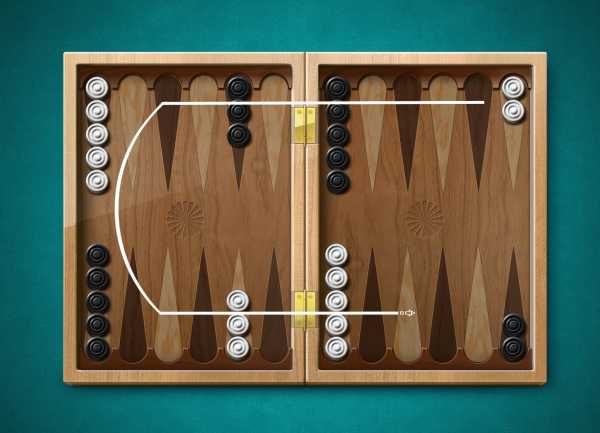
ДВИЖЕНИЕ ШАШЕК
Чтобы начать игру, каждый игрок бросает одну кость. Этим определяется, какой из игроков ходит первым и какие числа для своего первого хода он использует. Если у обоих игроков выпали одинаковые числа, они оба кидают кости до тех пор, пока не выпадут различные значения. Игрок, у выпало большее число, передвигает свои шашки в соответствии с числами на обоих костях. После первого хода, игроки поочередно бросают по две кости и выполняют ходы.
Число на каждой кости показывают, на сколько пунктов, или пипсов, игрок должен передвинуть свои шашки. Шашки всегда движутся только в одном направлении, от пунктов с большими номерами к пунктам с меньшими. При этом применяются следующие правила:
1. Шашка может двигаться только на открытый пункт, то есть на такой, который не занят двумя или более шашками противоположного цвета.
2. Числа на обеих костях составляют отдельные ходы. К примеру, если у игрока выпало 5 и 3, он может пойти одной шашкой на три поля, а другой — на пять, либо он может пойти одной шашкой сразу на восемь (пять плюс три) поля, но последнее лишь в том случае, если промежуточный пункт (на расстоянии три или пять полей от начального пункта) также открыт.
3. Игрок, у которого выпал дубль, играет каждое из чисел на каждой из костей дважды Например, если выпало 6-6, то игрок должен сделать четыре хода по шесть очков, и он может передвинуть шашки в любой комбинации как сочтет нужным.
4. Игрок должен использовать оба числа, которые ему выпали, если они допускаются правилами (либо все четыре числа, если у него выпал дубль). Когда можно сыграть только одно число, игрок обязан сыграть это число. Если каждое из чисел по-отдельности можно сыграть (но не оба вместе), игрок должен играть большее число. Если игрок не может сделать хода, то он пропускает ход. В случае, если выпал дубль, если игрок не может использовать все четыре числа, он должен сыграть столько ходов, сколько возможно.
Рис 3. Два способа, которыми белые могут сыграть
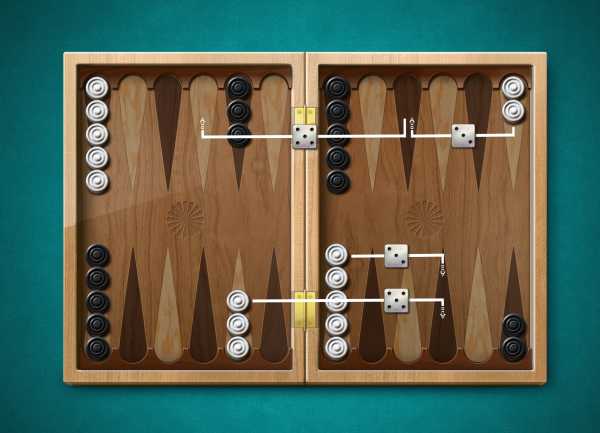
КАК ПОБИТЬ И ЗАРЯДИТЬ ШАШКУ
Пункт, занятый только одной шашкой, носит название блот. Если шашка противоположного цвета останавливается на этом пункте, блот считается побитым и кладется на бар. В любой момент, когда одна или несколько шашек находятся на баре, первая обязанность игрока — это зарядить шашки в доме соперника. Шашка вступает в игру, перемещаясь на пункт, соответствующий выброшенному значению кости.
К примеру, если игроку выпало 4 и 6, он может зарядить шашку в четвертый либо в шестой пункты, если они не заняты двумя или более шашками противника.
Если оба пункта, соответствующие значениям выброшенных костей, заняты, игрок пропускает свой ход. Если игрок может ввести некоторые из своих шашек, но не все, он должен зарядить все шашки, которые возможно, и затем пропустить оставшуюся часть хода. После того, как все шашки будут введены с бара, неиспользованные значения костей можно использовать, как обычно, перемещая шашку, которую вы зарядили, либо любую другую шашку.
Рис 4. Если белым выпало, но одна из из шашек на баре, они должны зарядить шашку в пункт 4 в доме черных, поскольку пункт 6 занят черными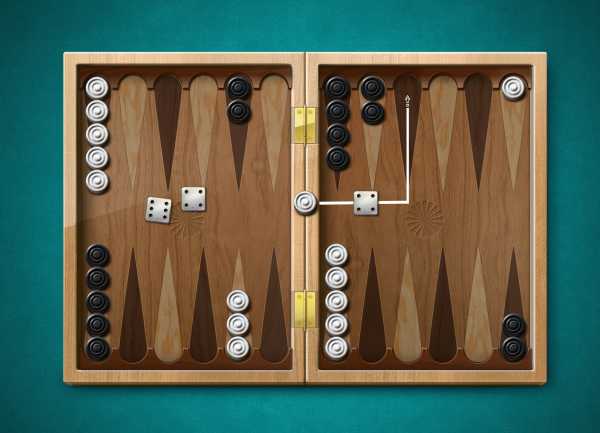
ВЫБРОСЫВАНИЕ ШАШЕК
Когда игрок привел все свои пятьнадцать шашкек в свой дом, он может начать выбрасывать их с доски. Игрок выбрасывает шашку следующим образом: Бросается пара костей, и шашки, которые стоят на пунктах, соответствующих выпавшим значениям, снимаются с доски. Например, если выпало 6 очков, можно снять шашку с шестого пункта.
Если на пункте, соответствующем выпавшей кости, нет ни одной шашки, игроку разрешается переместить шашку с пунктов, больших чем выпавшее число. Если игрок может сделать какие-либо ходы, он не обязан выбрасывать шашку с доски
В стадии выбрасывания шашек все шашки игрока должны находиться в его доме. Если шашка будет побита в процессе выбрасывания шашек, то игрок должен привести шашку обратно в свой дом, прежде чем он продолжит выбрасывать шашки. Тот, кто первый снял все шашки с доски, выигрывает партию.
Рис 5. Белым выпало — они выбрасывают две шашки
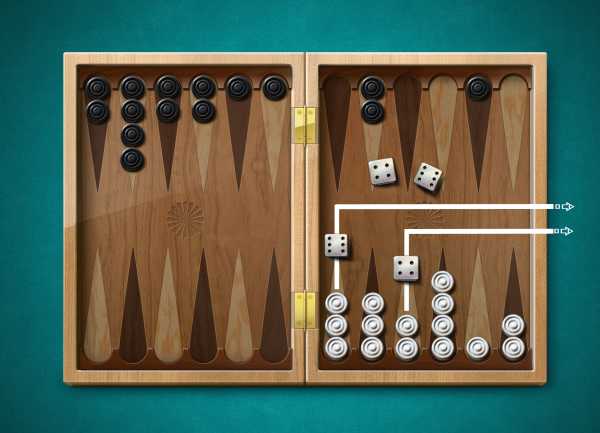
РЕЗУЛЬТАТ ИГРЫ
Ничьей в нардах нет. Если один игрок выбросил все свои шашки первым, второй считается проигравшим, даже если следующим броском тоже может выбросить все свои шашки.ВАРИАНТ ЗАВЕРШЕНИЯ ИГРЫ
- ОИН
положение шашек в конце игры, при котором проигравший успел снять хотя бы одну свою шашку с доски. 1 ОЧКО. - МАРС
положение шашек в конце игры, при котором проигравший не успел завести в свой дом все свои шашки, в то время как оппонент успел снять
все свои шашки с доски. 2 ОЧКА - КОКС
положение шашек в конце игры, при котором проигравший не успел вывести одну или несколько шашек из дома противника. 3 ОЧКА
nardionline.net
GAME RULES FOR Short BACKGAMMON from www.NardiOnline.Net
STARTING POSITION
Backgammon — a game for two players on a board consisting of twenty-four narrow triangles called item. Triangles alternate in color and are grouped into four groups of six triangles each. These groups are called — the house, the yard, the house of the enemy, the enemy courtyard. The house and yard are separated by a bar, which stands above the playing field.Items are numbered separately for each player, starting with the home the player. The farthest point is the 24th item; it is also the first point for the opponent. Each player has 15 checkers. Initial setup of checkers is: each player two checkers in the twenty-fourth paragraph, in the thirteenth — five, three in the eighth and five in the sixth.
Pict 1. Board with checkers in the starting position. A possible arrangement is also, mirror symmetrical to that depicted in the figure. The house is located in her left, and the yard — right respectively.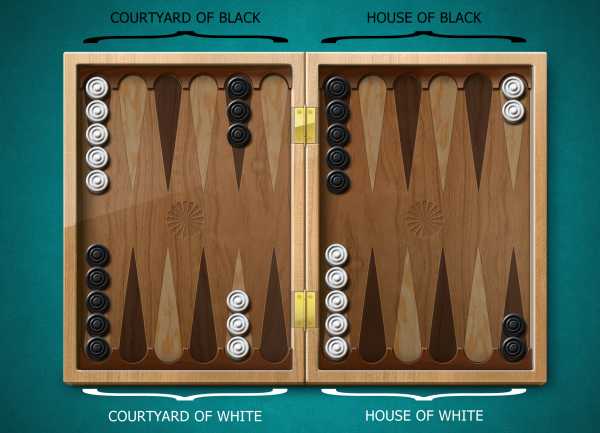
PURPOSE OF THE GAME
The goal — to convert all your checkers into home and then remove them from the board. The first player who has removed all of his checkers wins the game. Pict 2. Direction of movement of white checkers. White Checkers are moving in the opposite direction.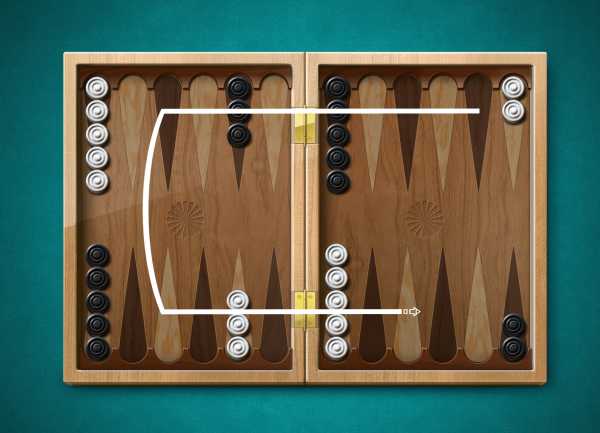
MOVEMENTS OF CHECKERS
To begin the game, each player rolls one die. This determines which player goes first and what numbers for his first stroke he uses. If two players have the same number dropped, they both roll the dice as long as different values will not fall out. A player who has dropped a higher number moves his checkers according to the numbers on both dice. After the first move, the players alternately throw two dice and perform moves.
The number on each dice indicates how many points, or pips, the player must move his checkers. Checkers always move only in one direction from large numbers of points to the points with smaller. In this case the following rules apply:
1. Checker can only move to an open point, i.e. one that is not occupied by two or more drafts of the opposite color.
3. Player who rolls doubles plays each of the numbers on each of the bones twice example, a roll 6-6, the player must make four moves by six points, and he may move any combination of checkers as it sees fit.
4. Player must use both numbers of which he fell, if they allowed the rules (or all four numbers, if he rolls doubles). When you can play only one number, the player must play that number. If each of the numbers separately, you can play (but not both), the player must play the higher number. If a player cannot make a move, he loses his turn. If rolls doubles, if a player cannot use all four numbers, he should play as many moves as possible.
Рис 3. Two ways that White can play
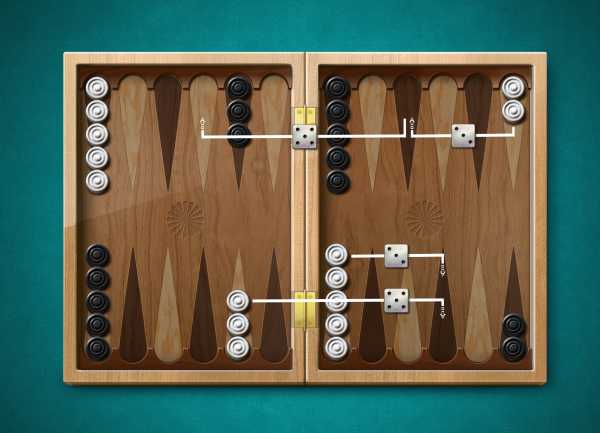
HOW TO HIT A CHECKER
A point occupied by only one checker is called blot. If a checker of the opposite color stops at this point, the blot is hit and placed on the bar. At any time, when one or more pieces are on the bar, the first duty of the player — it’s in the house to charge checkers opponent. Checker comes into play, moving to the point corresponding to the value of discarded bones.
For example, if a player rolls 4 and 6, it can charge for the fourth bomb or sixth item if two or more enemy checkers does not occupy them.
If both points corresponding to the values of discarded bones, busy, the player loses his turn. If the player can enter some of his checkers, but not all, he has to charge all checkers that possible and then skip the rest of the turn. After all drafts will be put on the bar, the unused value of bones can be used as usual, moving his checker, which you charge, or any other checker.
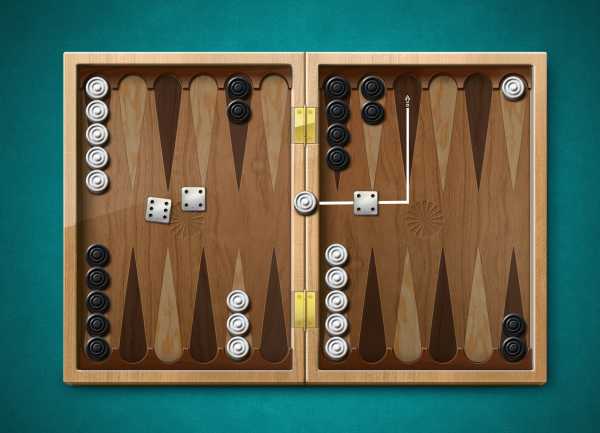
THROWING OUT CHECKERS
When a player has moved all its 15 checkers to his house, he can start throwing them off the board. The player throws his checkers as follows: Giving a pair of dice and checkers, which are on the points corresponding to the fallen values removed from the board. For example, if dropped 6 points, you can remove the checker from the sixth item.
If at the point indicated by the roll, no checkers player is allowed to move checkers to points larger than the number drawn. If a player can make any moves, he is not obliged to throw checker
When throwing out checkers, all the checkers must be in the house. If a checker is beaten in the discharge of checkers, the player must bring his checker back to his house before he will continue to throw them out. The one who first throws out all his checkers off the board wins the game.
Рис 5. White dropped — they emit two checkers
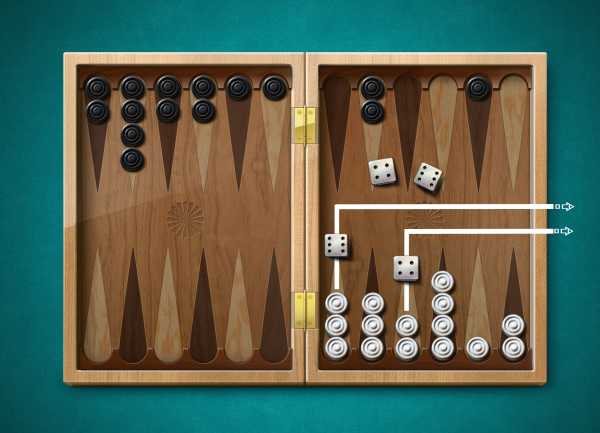
GAME RESULTS
Backgammon does not have draw. If one player threw all his checkers first, the second is a loser, even if the next roll can throw all their pieces.- SPE
Checkers position late in the game in which the loser had to withdraw at least one of his checkers. 1 POINT. - MARS
Checkers position late in the game in which the loser has not starts in your house all their pieces, while the opponent had to withdraw All of his checkers from the board. 2 POINTS - COKE
Checkers position late in the game in which the loser has not managed to bring one or more pieces of the opponent’s home. 3 POINTS
nardionline.net
GAME RULES FOR LONG BACKGAMMON from www.NardiOnline.Net
TERMINOLOGY.
GENERAL PROVISIONS
Backgammon is held between the two rivals, each of which has 15 checkers on one point on the left side of the board ( «start» ) . Moving the checkers is counterclockwise. The aim of the game is to pass all the checkers full circle and throwing them before the opponent. .
Pict.1. Board for long backgammon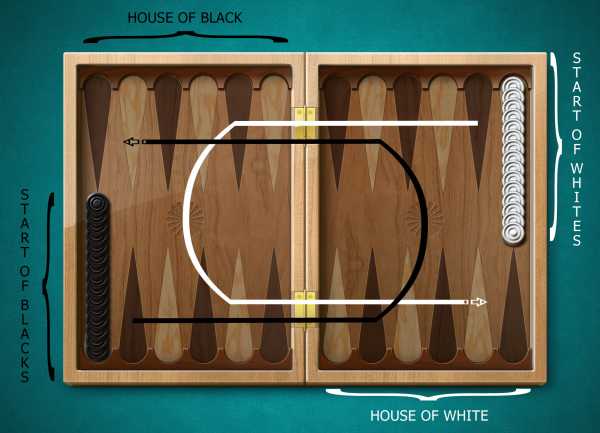
RIGHT OF THE FIRST MOVE
Each player rolls one dice. Whoever drops more points will go first. Before the loss of the double throw its repeated. If, after one party they start the second game, the winner will go first.
MOVEMENTS OF PIECES
In backgammon player rolls two dice. After throwing one man moves to the number of points corresponding to the points on the same cube, and the second cube (or the same one) — The number of points corresponding to the points on the second cube. It does not matter according to which dice player moves the checkers.
Pict.2. DROPPED «TWO» & «SIX».
The first version of stroke:
Stay in one checker with the «Start» and move it to 2 points and another checker move by 6 points.
The second option reserve:
Move one of the checkers by 8 points.
Pict.2. 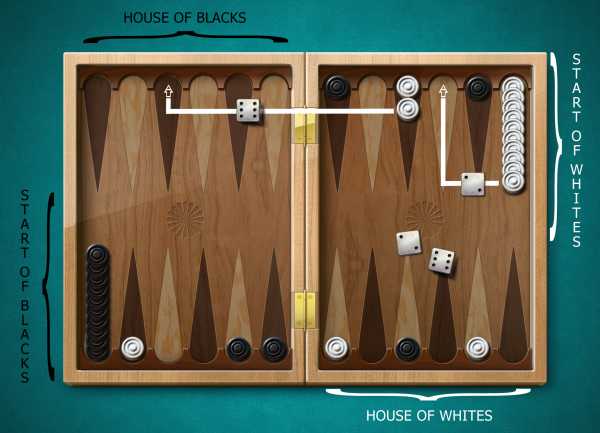
When starting player can take only one checker. The exception is in the beginning of the game (for example, combinations of dice six — six, four — four, three — three), when checker hits the opponent occupied points. In this case, go with two checkers.
If both dice fell the same number of points (double), the player is able to do not two, but four stroke on the number of points corresponding to the points on one of the dice.
If the player can not move his checkers on the number of points corresponding to points on the cubes dropped (checkers fall into occupied rival points) , he loses his turn . Conversely, if the move is possible, the player is obliged to do, even if this move is disadvantageous to him.
If points fell on one of the dice that cannot be used, they are lost. In this case, the player makes a move with only one checker. If both are available to move (according to points at dawn one or two dice), the player must make a move using two charge points (Pict. 3).
If you can move only one of the two pieces (i.e. move one excludes the possibility of checkers another stroke), the player must make a move according to the dawn with the most points ((Pict. 4)).
Pict. 3. 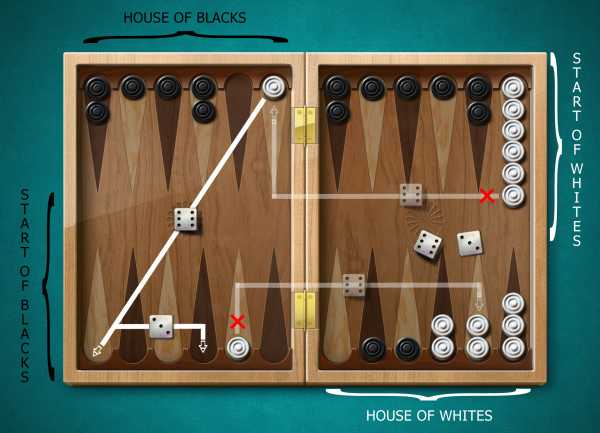
Pict. 4. Dropped «two» and «three». You can move only one checker, or two, or three points. Under the rules of whichever is greater credit checker moves on three points.
Pict. 4. 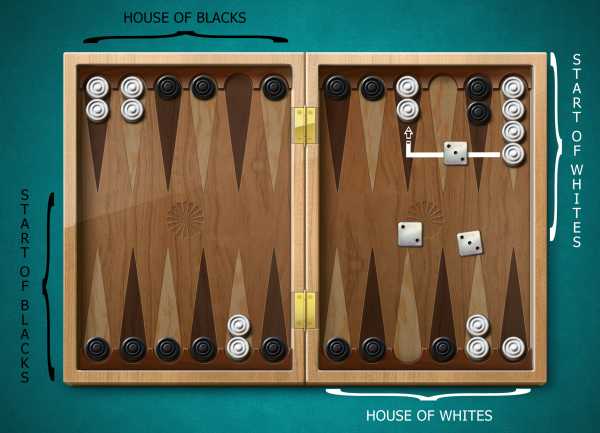
GETTING CHECKERS OUT OF THE BOARD
«To throwing out the checkers » — means to make moves, after which checker is outside the board. You can only throw checkers when all player’s checkers are in the house . Checkers can be disposed of only with the items corresponding to points fallen on the dice. (Pict. 5) . Player is allowed to take out checkers with lower rank fields if the fields of higher checkers are not available .
Pict.5. All white checkers came to the house. Now the player can «throw-away » them. Dropped «four» and «six». Throw a checker in the fourth row, and one checker from the sixth row.
Pict. 5. 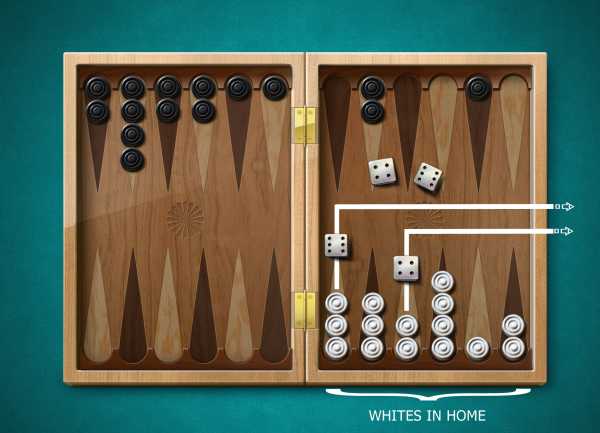
GAME RESULTS
Backgammon does not have draw . If one player threw all his checkers first, the second is a lose, even if the next roll , too, can throw all their pieces .
OPTIONS OF GAME’S RESULTS
- SPE
Checkers position late in the game in which the loser had to withdraw at least one of his checker. 1 POINT. - MARS
Checkers position late in the game in which the loser has not finished to move all checkers in his house, while the opponent had to withdraw all of his checkers from the board. 2 POINTS - HOME MARS
Checkers position late in the game in which the loser had checkers in his house, but did not throw out any of them. 3 POINTS - COKE
Checkers position late in the game in which the loser has not managed to bring one or more pieces from their initial (starting) quarter. 4 POINTS
nardionline.net
